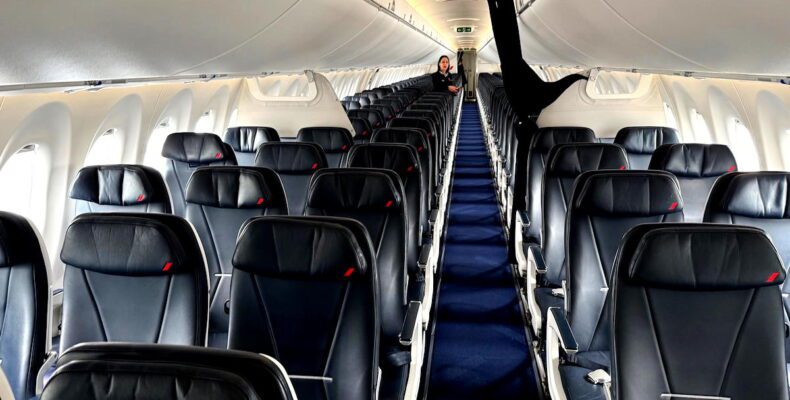Revolutionary 160-Seat Airbus A220 Variant
Ah, the Airbus A220. Initially dubbed the Bombardier CSeries, this aircraft sweetens the skies with its pleasant 2-3 seating arrangement and respectable legroom. But brace yourself, travelers, because what you cherish might just become a little snugger. Airbus is shaking things up with a new twist on this beloved model.
Airbus Eyes a Higher Capacity A220: Packing in 160 Seats
Currently, we’ve got two flavors of the A220 to choose from—A220-100 and the roomier A220-300, which seats up to 149 people. Aircraft are capped at these numbers due to strict rules, primarily around safely evacuating everyone onboard in an emergency.
Hold onto your hats, because Airbus has its sights set on cramming in more passengers. They’re looking to certify a new version of the A220-300 boasting a whopping 160 seats. The aircraft remains the same size, but with a bit of a makeover—a second set of exit doors over the wings to allow for the extra folks.
The grand plan is to have this version ready to fly by 2026. Just so you know, airlines will need to specifically order this jam-packed edition; the traditional A220-300 won’t be going anywhere, complete with its singular over-wing exit. And don’t mix this up with whispers about an A220-500—an even bigger stretch of the A220-300—Airbus is mulling over for the future.
More Seats, More Appeal for Low-Cost Carriers
Your regular airlines likely won’t rush to grab a high-density A220. Why? They don’t pack airplanes to the brim to suit their upscale brand. It’s the budget-friendly airlines where this aircraft might find a home.
- Imagine how cozy—a version of the A220-300 stretching to accommodate 160 seats might feel. To give perspective, airBaltic, a major player in the A220 arena, has models carrying 150 passengers in 30 rows, with a 2-3 seat pattern.
Toying with numbers, if you add those two extra rows, you’re eyeing a seat pitch squishing down to around 28 inches. Not a comfortable prospect, not least because extra legroom is necessitated by the second exit row.
Airlines might also squeeze out some gains by downsizing galleys and bathrooms. So even if comfort takes a hit in this seating chart, the nicer 2-3 layout means fewer unfortunate souls get stuck in middle seats versus the average 3-3 layout. That’s something, right?
Drumroll for the Downsides
Naturally, more passengers demand more care, which means a fourth flight attendant. Ah, but there’s a catch—will packing in 10 more fares pay off in the reals of airline mathematics? It’s a toss-up whether those extra tickets consistently sell to make the added staff worthwhile.
In Summary
Folks, Airbus is on track to roll out a beefed-up version of the A220-300, aiming to bump up seating from 149 to 160 with a clever tweak—adding another exit over the wings. This design could be a hit among budget airlines that so far haven’t been all that into the A220.
So, what’s your take on the budding plans for a densely packed A220-300? Would you endure a bit more “closeness” on your next flight?
